From start-ups to banks, design has never been more central to business. Yet at conference after conference, I meet designers at firms talking about their struggle for influence. Why is that fabled “seat at the table” so hard to find, and how can designers get a chair?
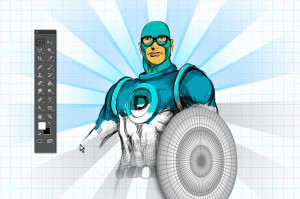
Designers yearn for a world where companies depend on their ideas but usually work in a world where design is just one voice. In-house designers often have to advocate for design priorities versus new features or technical change. Agency designers can create great visions that fail to be executed. Is design just a service, or can designers* lead?
*Meaning anyone who provides the vision for a product, whether it be in code, wireframes, comps, prototypes, or cocktail napkins.
Does a designer just make pictures?
In years of presentations working at an agency, I learned to sense the tension building before a design was revealed. At a certain point, clients stop listening to the strategy—they just want to get to the pictures.
But does that mean that designers should just make pictures and leave the strategy to others? No. No one wants to be a mere stylist, but it can be hard to lead when you feel typecast as a pixel pusher.
Communication is the core skill of a designer—every other ability depends on it.
The best designers transcend the gap between strategy and execution. They know that communication is the core skill of a designer: We don’t make the thing; we show how it should be made. But rather than seeing picture-making as a mere stepping stone toward strategy, we can use it as our “super power” to lead.
I have the good fortune to work with a talented illustrator. She uses the same tools I have, but when she touches them, drawings appear. It’s like a super power! That is the same impression people have of a good designer. But how do you lead with pictures and not simply push pixels? Let’s a closer look at unlocking the designer super power.
Pictures are power
Imagine getting two ideas for a new product. One person described the idea in an elevator pitch; another showed you a mock up. Which one would you listen to? Which seemed like they made more effort and had explored the idea further?
A good visualization gives the designer influence that goes beyond rank or title. Pictures expand the collective imagination, making abstract ideas tangible and build-able.
A junior designer I once worked with made a comp of a new dashboard idea in her spare time and emailed it out. It bounced around the organization and got taken up by the president as their future vision. Was it fully thought out? No. Did it instigate change? Definitely.
Anyone can write bullet points; few can communicate what an experience will feel like.
Designers complain about executives meddling with designs, but seen another way, designers have access to leaders most other roles never get. The only time a database admin gets executive attention is when the web site crashes. The best designers take advantage of the opportunity to engage in a strategic discussion.
Design itself is a product
Many groups in an organization have a thing that they “own” that gives them leverage in decisions. Developers own the code, business owns the proposition, yet design is considered a “service.” One opportunity for designers is to “own” the future, to use their unique skills to document and maintain the future state of the product.
We all sketch before we design, but too often the sketches go in a drawer when the project starts, often never to be seen again. What if designers were responsible for delivering the short term design documentation AND keeping the long-term vision alive?
“If a picture is worth 1,000 words, a prototype is worth 1,000 meetings.” —saying at Ideo
One team I’ve worked with helps bridge this gap on strategic projects by maintaining an “experience roadmap.” The roadmap is a collection of prototypes showing what each release will look like. The team also keeps the design vision up to date, updating it as they learn from customers. Agile teams can lose the long term direction by focusing on small sprints. These designers influence the strategy by showing how each release moves toward the ultimate vision.
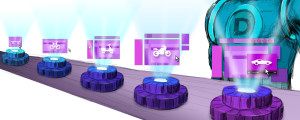
Sort of like version control for something that doesn’t exist yet, the roadmap highlights the main “branch,” shows the variations explored, and documents the business and design decisions.
The roadmap doesn’t just benefit the project team or the designer. When you work at a large firm with many teams, communication is essential. As one business partner said, “I could spend all my time just keeping up with that everyone else is doing.” Creating design documents that solve problems for the whole team increases your influence.
Incubate ideas with visuals
I’ll let you in on a business secret: Most business plans are only sketches; even their creators aren’t half as confident as they want to be. They’d like to engage a designer, but many don’t think they can afford it. UX ideology can hurt also. Hearing that design means a “four step user-centered design process with a team of five people for six months” can convince people to skip design right when it is most helpful: the beginning.
Working with half-baked ideas could be a nightmare project (I know several designers who have vowed to never work with start ups again), but it’s also an opportunity for designers to lead. The key is being willing to collaborate and get outside of our comfort zone.
“Designers can be solitary people who emerge from their work with the answers that will fix everything. Wrong.” –Bradford Shellhammer
Designers all over complain about being brought in too late to a project. To break this conflict between early access and full process, our group developed a process to help executives visualize their ideas. Nicknamed “FutureMap,” it is creative session to document an idea in its earliest stage.
We gather a small group of partners to hash through the idea on whiteboards with a designer listening in and working live on the projector in the background. In a few hours, we have enough to communicate the idea and build excitement. We also build relationships. When the project is ready, you know that designer is going to have a seat at the table.
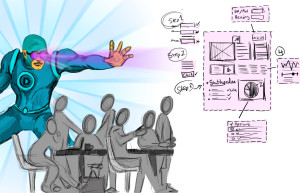
Always be closing
In the heat of a project, most designers focus on the product itself, but every product will have to be promoted and sold. Whether the customer is an individual consumer or an internal partner, your success depends on communicating what a product is and why someone should care.
Embracing marketing is a powerful way designers can lead product strategy. In the earliest stage, before any code is written, only designers can get customer feedback. Lean startups like to talk about minmum viable product as the smallest amount of effort to validate an assumption, but it is odd that they jump right into coding. The fastest way is almost always making pictures. Every designer already has the tools on their computer to answer product questions by engaging with the customer.
Even before you design the full product, design how you are going to communicate the value.
- Use InDesign to make a brochure. Get feedback in a train station.
- Use iMovie to make a fake TV ad. Get feedback online.
- Use Dreamweaver to make a home page. Measure clicks on Google Analytics.
Some may feel that marketing is not part of user experience, but talking to real customers is the only way to get honest feedback. If you can’t sell a feature, maybe you shouldn’t build it. This has the potential to focus the product and save hundreds of hours of development. If you do it right, you will end helping to drive the product strategy.
A user researcher I work with became a leader when she demonstrated that you could usability test a value proposition. She made A/B variations of a marketing page, each with showing different features. Online testing tools like Loop11 or usertesting.com make it easy to show a page to a couple hundred people and see who clicks the link. You can then follow up with questions on how well they understood the offer.
Making pictures helps us think
There is an old joke about politician logic:
- There is a problem. We must do something
- [X] is something
- Therefore, we must do [X]
Sadly, this isn’t limited to politicians. One of the less appreciated audiences of making pictures is the team itself. Any group of people working closely under pressure faces the invisible risk of tunnel vision or group think. Who hasn’t been surprised when a design idea, that seemed obviously right, stumps users in testing?
The best way to avoid it is to not have an idea. Have two ideas. Think of it as A/B testing throughout the design cycle. It’s one of the core ideas of our team’s UXD process; any concept phase must produce at least two options that can be tested. We do this to make sure we fully develop each instead of compromising two ideas. The most common conflict is between the expert user and the novice. Melding their needs is the best way to create bad design. Instead, design each and test. Who knows—maybe the experts enjoy the simplicity of the novice design!
There is a psychological angle to this. Many designers struggle when they see a specific design as “their baby.” Having multiple children, so to speak, helps us fall in love with problem, not the solution. This keeps us focused on leading the team toward the best solution and away from defending a flawed design.
Defeating “designer kryptonite”
There is one last aspect of your super power: You will lose it if you stop using it. I interviewed a smart candidate recently. He had great things to say about Scrum, meeting delivery deadlines, business metrics… but his visuals were no different than any business analyst. He had lost the creative spirit.
Designers on long-term projects risk exposure to “designer kryptonite”—the thousand tiny compromises due to politics, budget, legal, and our old friend “time to market.”
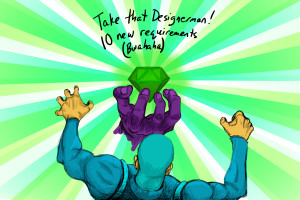
Putting your creative self out there is draining. Design that inspires your company requires we reignite the creative passion from time to time. Conferences can help, but sometimes it is as simple as having a supportive event to remind us why we became designers in the first place.
Our team runs design challenges every few months. These are open entry design competitions where any designer can sketch a design without the usual requirements. Doing pure design in a social environment is great fun and produces great work. More than once, these radical visions inspired our partners to kick off a project and take it to market.
Lead by (visual) example
People usually think leadership means just telling everyone what to do, but a more effective style is servant leadership. By solving other people’s problems, by making them successful, you become a great leader. Like user centered design itself, designers have the ability to use their skills to help the people on their team.
Yes, this is more effort, but it is the kind of effort we got into design for. You don’t need to be bitten by a radioactive spider or come from another planet. What special powers do you have? How can you use them to help others and lead?
Illustrations by Laura Fish.

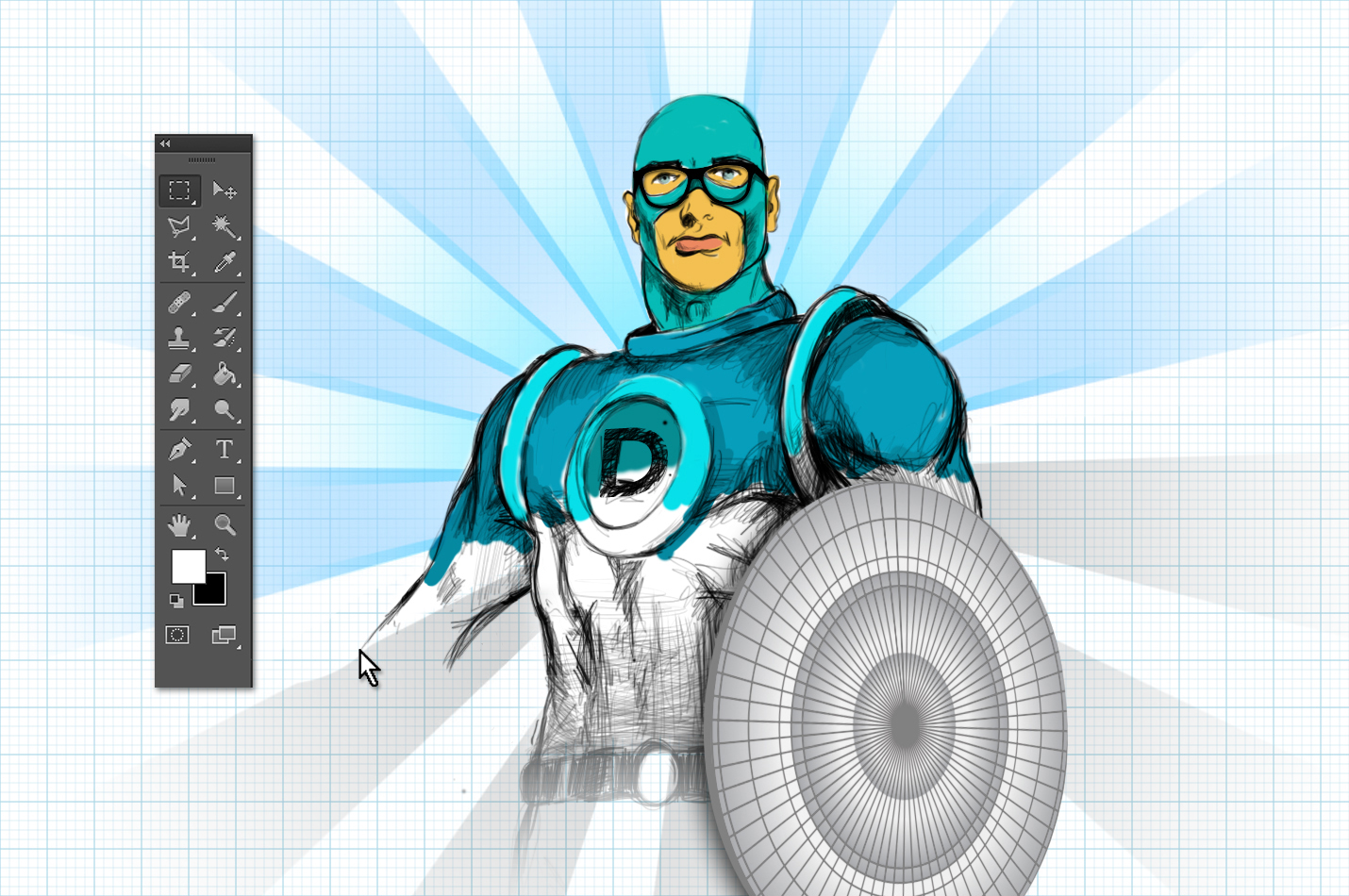
I have a lot to say on this. The short: every idea is half-baked. It’s an idea. 🙂
Nice thoughts, Stephen. Beyond prototypes, designers also leverage visualization skills for things like mapping experiences, which allow us to be facilitators or broader conversations in the org.
Great article, love the call to arms! We could all use a reminder to embrace our inner powers. The illustrations really bring the ideas to life!
Thanks! Some good tips there, especially about having competing designs. This would help clients not focus all their ideas into one franken-design. OMG I’ve gotten so much designer kryptonite in my life!
Great article, good tips!!! I believe many of us are losing against mediocre “Devs tech designers” they were changing the names of things already design a long time ago and trying to reinvent the wheel… I just can’t believe that no one is creating new things basically now everyone is using “Google Material Design” That’s basically using the same suit for everything.